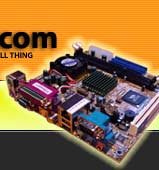Fan
Noise and Cooling
The EPIA 5000 and EPIA ME6000 are passively
cooled and therefore require no fans. They both use large
aluminium heatsinks to remove heat from their Eden CPUs. These
boards are ideal for situations where totally silent computing
is required. The 800 and M9000 both cool their C3 CPUs with
a 40mm square 12V AVC C4010T12H fan sitting
atop a shorter heatsink. The fan has a maximum airflow of
7.87 CFM, noise level of 29.0 dB and rotates at 6200 rpm.
The M10000 introduced a new CPU fan, larger
CPU heatsink and a new double heatsink arrangement cooling
the Northbridge and for the first time, the Southbridge. The
fan is a 12V BI-Sonic BS401012M with
a maximum airflow of 6.48 CFM, noise level of 24.5 dB and
rotates at 5000 rpm. It should therefore be quieter than the
earlier fan.
We compared the two fans together, and found
the BI-Sonic used on the M10000 to be quieter than the AVC.
The AVC had a slight irregularity to its tone, where the M10000
simply spun quietly, fairly quickly. This isn't to say either
were loud - they are both much quieter than the average 80mm
case fan and in keeping with the EPIAs "near silent computing"
philosophy. We have found some AVC fans do get louder over
time - a rheostat such as the Zalman FanMate can slow down
troublesome fans and lower their noise levels with no adverse
effects.
Power Consumption
VIA claim a 10% drop in power consumption
for the Nehemiah M10000, which would give it a maximum power
consumption of about 23 or 24W under heavy load. The M9000
runs at about 17W when idle and 26W under load, the ME6000
about 3W below that and the 800 about the same under load
but only requiring 10W when idle. The EPIA 5000 is the machine
that consumes the least power - idling at 9W and running at
16W under load. And this is for the entire motherboard - compare
and contrast with an Athlon or Pentium consuming 70-90W.
Low power consumption is central to VIA's
philosophy - it means reduced heat generation, which means
in turn reduced cooling required, which leads to quieter and
smaller PCs, which makes for a better working environment.
Overclocking
Many of today's CPUs are capable of being
overclocked. Athlons and Celerons can often be driven far
beyond their rated speed, and many owners now overclock their
CPUs as a matter of course. This of course generates more
heat, which isn't really in keeping with the EPIA design philosophy.
We had to try though. The C3 stores its multiplier setting
on the MSR level within internal registers, i.e. alterable
in software for the life of your operating system session.
If you go too high don't worry - the multiplier setting will
default to factory values on the next reboot. FSB settings
aren't alterable in the BIOS - not in the right direction
anyway.
We tried to alter our Nehemiah multiplier
(default settings are 7.5 x 133MHz) using WCPUID
- but it wouldn't budge using our version of the software.
Shame - it works for all the other EPIAs. In theory it would
be possible to take a lead pencil to the bridges atop a Nehemiah
C3 after ripping off the heatsink - this of course is a hugely
warranty invalidating procedure. And every time you try it,
a kitten dies.
EPIA
Linux Support
We're not Linux experts here at Mini-ITX.
We do know that support for the multimedia features of the
EPIA M has been thin on the ground, but is improving. Source
code has only recently been released to enable these features,
prior to that only binary drivers were available. We have
installed Redhat 8.0 fine on EPIAs and EPIA Ms, but not used
them extensively - there's only so many hours in the day!
We wouldn't want to try to comment knowledgeably on the current
status of Linux on the EPIA range. If anyone thinks they can
- feel free to contact us.
EPIA Video
Resolutions -->







